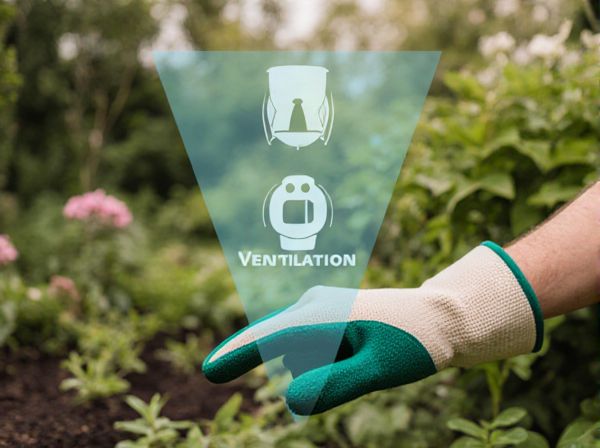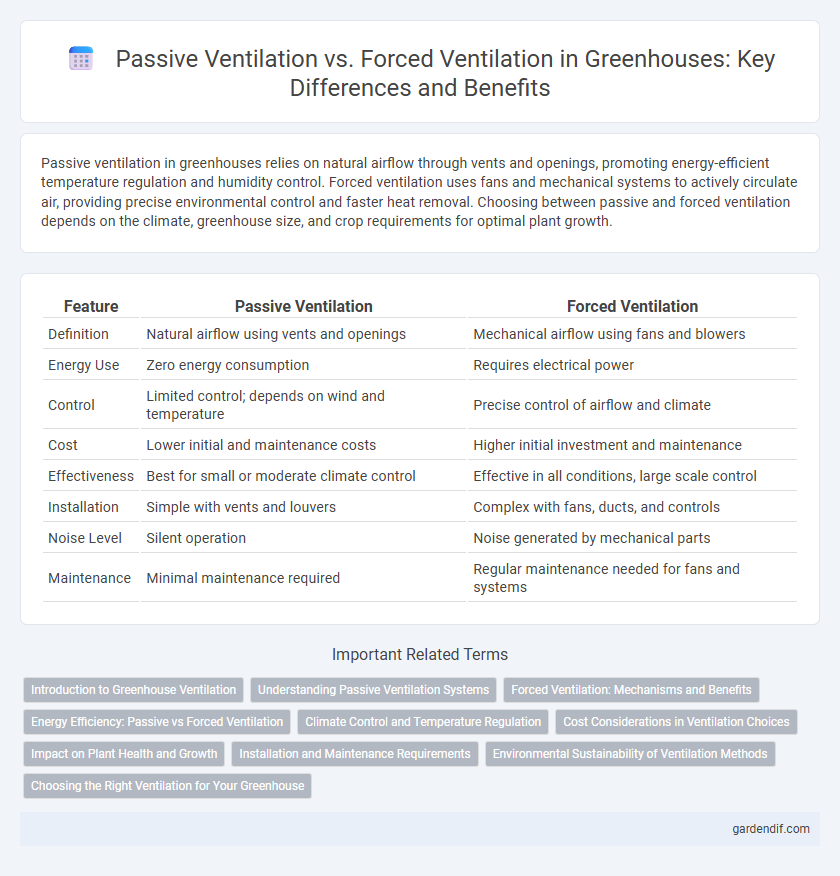
Passive ventilation vs Forced ventilation Illustration
Passive ventilation in greenhouses relies on natural airflow through vents and openings, promoting energy-efficient temperature regulation and humidity control. Forced ventilation uses fans and mechanical systems to actively circulate air, providing precise environmental control and faster heat removal. Choosing between passive and forced ventilation depends on the climate, greenhouse size, and crop requirements for optimal plant growth.
Table of Comparison
| Feature | Passive Ventilation | Forced Ventilation |
|---|---|---|
| Definition | Natural airflow using vents and openings | Mechanical airflow using fans and blowers |
| Energy Use | Zero energy consumption | Requires electrical power |
| Control | Limited control; depends on wind and temperature | Precise control of airflow and climate |
| Cost | Lower initial and maintenance costs | Higher initial investment and maintenance |
| Effectiveness | Best for small or moderate climate control | Effective in all conditions, large scale control |
| Installation | Simple with vents and louvers | Complex with fans, ducts, and controls |
| Noise Level | Silent operation | Noise generated by mechanical parts |
| Maintenance | Minimal maintenance required | Regular maintenance needed for fans and systems |
Introduction to Greenhouse Ventilation
Greenhouse ventilation is essential for regulating temperature, humidity, and air quality to promote optimal plant growth. Passive ventilation relies on natural airflow through vents and openings driven by wind and thermal buoyancy, providing energy-efficient airflow without mechanical aid. Forced ventilation uses fans and blowers to actively move air, ensuring precise environmental control and enhanced circulation in larger or densely planted greenhouses.
Understanding Passive Ventilation Systems
Passive ventilation systems in greenhouses rely on natural airflow driven by temperature differences and wind, reducing energy consumption and maintenance costs. These systems use strategically placed vents, louvers, and openings to facilitate air exchange, improving temperature regulation and humidity control without mechanical assistance. Understanding passive ventilation enhances greenhouse efficiency by optimizing plant growth conditions through sustainable airflow management.
Forced Ventilation: Mechanisms and Benefits
Forced ventilation in greenhouses uses mechanical systems such as fans and blowers to actively circulate air, ensuring consistent temperature and humidity control. This mechanism enhances plant growth by preventing heat buildup, reducing excess moisture, and promoting CO2 distribution essential for photosynthesis. Compared to passive ventilation, forced ventilation offers precise environmental regulation, which is critical for high-yield and disease-resistant crop production.
Energy Efficiency: Passive vs Forced Ventilation
Passive ventilation in greenhouses utilizes natural airflow through vents and openings, significantly reducing energy consumption compared to forced ventilation systems. Forced ventilation relies on electric fans to regulate temperature and humidity, increasing operational energy costs but providing precise climate control. Energy efficiency in passive ventilation is maximized by strategic design and placement, while forced ventilation demands higher power usage but can support larger, more controlled environments.
Climate Control and Temperature Regulation
Passive ventilation in greenhouses relies on natural airflow through vents and openings to regulate temperature and humidity, promoting energy-efficient climate control. Forced ventilation uses mechanical fans and exhaust systems to actively manage air exchange, enabling precise temperature regulation and faster response to environmental changes. Choosing between passive and forced ventilation depends on factors like greenhouse size, local climate, and crop requirements for optimal climate control.
Cost Considerations in Ventilation Choices
Passive ventilation in greenhouses typically incurs lower initial installation costs since it relies on natural airflow through vents and openings, minimizing energy expenses. Forced ventilation systems demand higher upfront investment due to fans, motors, and electrical components, coupled with ongoing operational costs for power consumption. Evaluating long-term energy savings and maintenance fees is crucial when comparing cost-effectiveness between passive and forced ventilation methods.
Impact on Plant Health and Growth
Passive ventilation in greenhouses relies on natural air circulation, reducing humidity and preventing fungal diseases, which promotes healthier plant growth. Forced ventilation uses fans to control temperature and CO2 levels precisely, enhancing photosynthesis and accelerating plant development. Both methods influence plant health by managing microclimate conditions critical for optimal growth and productivity.
Installation and Maintenance Requirements
Passive ventilation in greenhouses requires minimal installation, relying on strategic vent placements and natural airflow, which reduces maintenance efforts and costs. Forced ventilation demands more complex installation of fans and ductwork, necessitating regular inspections, cleaning, and occasional repairs to maintain optimal performance. Proper maintenance of forced systems is crucial to prevent mechanical failures and ensure consistent airflow, whereas passive systems largely depend on structural integrity and vent cleanliness.
Environmental Sustainability of Ventilation Methods
Passive ventilation in greenhouses leverages natural airflow to regulate temperature and humidity, significantly reducing energy consumption and minimizing carbon emissions. Forced ventilation relies on mechanical systems like fans and exhausts, increasing energy use but offering precise climate control essential for crop optimization. Choosing passive ventilation enhances environmental sustainability by lowering the greenhouse's carbon footprint and operational costs, making it ideal for eco-friendly agricultural practices.
Choosing the Right Ventilation for Your Greenhouse
Choosing the right ventilation system for your greenhouse significantly impacts plant health and energy efficiency. Passive ventilation relies on natural airflow through vents and openings, ideal for small to medium-sized greenhouses in moderate climates, while forced ventilation uses fans and mechanical systems to regulate temperature and humidity precisely, suitable for larger or climate-controlled environments. Evaluating factors such as greenhouse size, local climate, crop requirements, and budget helps determine the most effective ventilation method for optimal growth conditions.
Passive ventilation vs Forced ventilation Infographic

 gardendif.com
gardendif.com